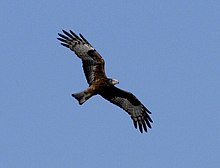
The wedge-tailed eagle is the largest bird of prey in the continent of Australia. It is also found in southern New Guinea to the north and is distributed as far south as the state of Tasmania. Adults of the species have long, broad wings, fully feathered legs, an unmistakable wedge-shaped tail, an elongated upper mandible, a strong beak and powerful feet. The wedge-tailed eagle is one of 12 species of large, predominantly dark-coloured booted eagles in the genus Aquila found worldwide. Genetic research has clearly indicated that the wedge-tailed eagle is fairly closely related to other, generally large members of the Aquila genus. A large brown-to-black bird of prey, it has a maximum reported wingspan of 2.84 m and a length of up to 1.06 m.
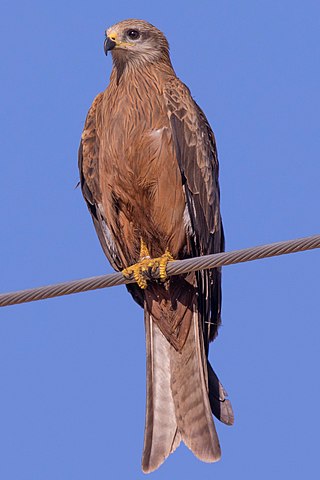
The black kite is a medium-sized bird of prey in the family Accipitridae, which also includes many other diurnal raptors. It is thought to be the world's most abundant species of Accipitridae, although some populations have experienced dramatic declines or fluctuations. Current global population estimates run up to 6 million individuals.
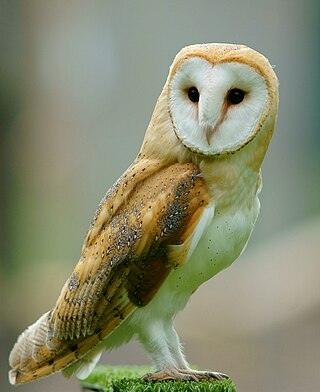
The barn owl is the most widely distributed species of owl in the world and one of the most widespread of all species of birds, being found almost everywhere except for polar and desert regions, Asia north of the Himalayas, some islands of Indonesia, and some Pacific Islands. It is also known as the common barn owl, to distinguish it from the other species in its family, Tytonidae, which forms one of the two main lineages of living owls, the other being the typical owls (Strigidae).

The black-shouldered kite, also known as the Australian black-shouldered kite, is a small raptor found in open habitats throughout Australia. It resembles similar species found in Africa, Eurasia and North America, including the black-winged kite, a species that has in the past also been called "black-shouldered kite". Measuring around 35 cm (14 in) in length, with a wingspan of 80–100 cm (31–39 in), the adult black-shouldered kite has predominantly grey-white plumage and prominent black markings above its red eyes. It gains its name from the black patches on its wings. The primary call is a clear whistle, uttered in flight and while hovering. It can be confused with the related letter-winged kite in Australia, which is distinguished by the striking black markings under its wings.

The nankeen kestrel, also known as the Australian kestrel, is a raptor native to Australia and New Guinea. It is one of the smallest falcons, and unlike many, does not rely on speed to catch its prey. Instead, it simply perches in an exposed position, but it also has a distinctive technique of hovering over crop and grasslands.

The red goshawk is probably the rarest Australian bird of prey. It is found mainly in the savanna woodlands of northern Australia, particularly near watercourses. It takes a broad range of live prey, mostly birds.

The African hawk-eagle is a large bird of prey. Like all eagles, it belongs to the family Accipitridae. This species’ feathered legs mark it as a member of the Aquilinae subfamily. The African hawk-eagle breeds in tropical Sub-Saharan Africa. It is a bird of assorted woodland, including both savanna and hilly areas but the tend to occur in woodland that is typically dry. The species tends to be rare in areas where their preferred habitat type is absent. This species builds a stick nest of around 1 m (3.3 ft) across in a large tree. The clutch is generally one or two eggs. The African hawk-eagle is powerfully built and hunts small to medium sized mammals and birds predominantly, occasionally taking reptiles and other prey as well. The call is a shrill kluu-kluu-kluu. The African hawk-eagle is considered a fairly stable species and a species of Least Concern per the IUCN.

The Mississippi kite is a small bird of prey in the family Accipitridae. Mississippi kites have narrow, pointed wings and are graceful in flight, often appearing to float in the air. It is common to see several circling in the same area.
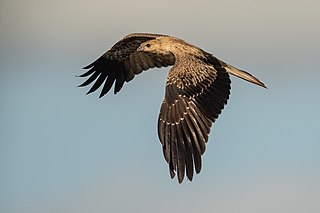
The whistling kite is a medium-sized diurnal raptor found throughout Australia, New Caledonia and much of New Guinea. Also called the whistling eagle or whistling hawk, it is named for its loud whistling call, which it often gives in flight. Some authorities put this species in the genus Milvus, despite marked differences in behaviour, voice and plumage between this species and other members of that genus.

The black falcon is a medium-large falcon that is endemic to Australia. It can be found in all mainland states and territories and yet is regarded as Australia's most under-studied falcon.

The Australian hobby, also known as the little falcon, is one of six Australian members of the family Falconidae. This predominantly diurnal bird of prey derives its name ‘longipennis’ from its long primary wing feathers. It occurs throughout Australia and other neighbouring countries with migrating individuals found on the islands of Indonesia and New Guinea.

The powerful owl, a species of owl native to south-eastern and eastern Australia, is the largest owl on the continent. It is found in coastal areas and in the Great Dividing Range, rarely more than 200 km (120 mi) inland. The IUCN Red List of Threatened Species also refers to this species as the powerful boobook.

The little eagle is a very small eagle endemic to Australia.

The Pacific baza, also known as the crested hawk, crested baza, and Pacific cuckoo-falcon, is a slender, medium-sized species of hawk in the family Accipitridae. It is mostly grey, brown, and white coloured and grows to a length of 35–46 centimetres (14–18 in). It is an omnivore and usually does not migrate. The breeding season for the species lasts from September to at least February, during which time specimens commonly fly and vocalise for display. It lives in Australia, Indonesia, Papua New Guinea, Solomon Islands, and East Timor, in forests, savannas, and freshwater bodies. The International Union for Conservation of Nature lists it as a least concern species.
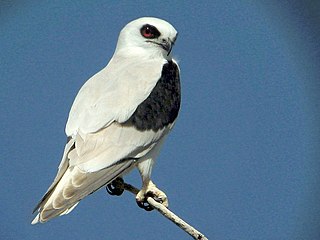
The letter-winged kite is a small, rare and irruptive bird of prey that is found only in Australia. Measuring around 35 cm (14 in) in length with a wingspan of 84–100 cm (33–39 in), the adult letter-winged kite has predominantly pale grey and white plumage and prominent black rings around its red eyes. Its name derives from its highly distinctive black underwing pattern of a shallow 'M' or 'W' shape, visible when in flight. This distinguishes it from the otherwise similar black-shouldered kite. This species is also the only nocturnal species within the order Accipitriformes despite few differences found in its visual anatomy to other closely related kites.

The black-breasted buzzard is a large raptor endemic to mainland Australia. First described by John Gould in 1841, it forms part of the family Accipitridae and is most closely related to the square-tailed kite. It is a versatile hunter known for its special skill in cracking eggs. The species is common throughout most of its range.

The collared sparrowhawk is a small, slim bird of prey in the family Accipitridae found in Australia, New Guinea and nearby smaller islands. As its name implies the collared sparrowhawk is a specialist in hunting small birds. It is characterised by its slight brow ridges and slender feet. The last segment of their middle toe projects beyond the claws of the other toes.

The grasshopper buzzard is a species of bird of prey in the family Accipitridae which is found in a narrow zone of sub-Saharan Africa north of the equator.

The white-throated nightjar or white-throated eared-nightjar is a species of nightjar in the family Caprimulgidae. It is endemic to eastern Australia; it is a non-breeding winter visitor in Papua New Guinea. Its natural habitat is subtropical or tropical dry forests.

The rufous owl, also known as the rufous boobook, is a species of owl in the family Strigidae. It was described in 1846 by John Gould, an English ornithologist. Its common name reflects the rufous-coloured feathers that these owls are covered with in adulthood. While it is uncommon, the species has a wide range, including Australia, Indonesia, and Papua New Guinea.
